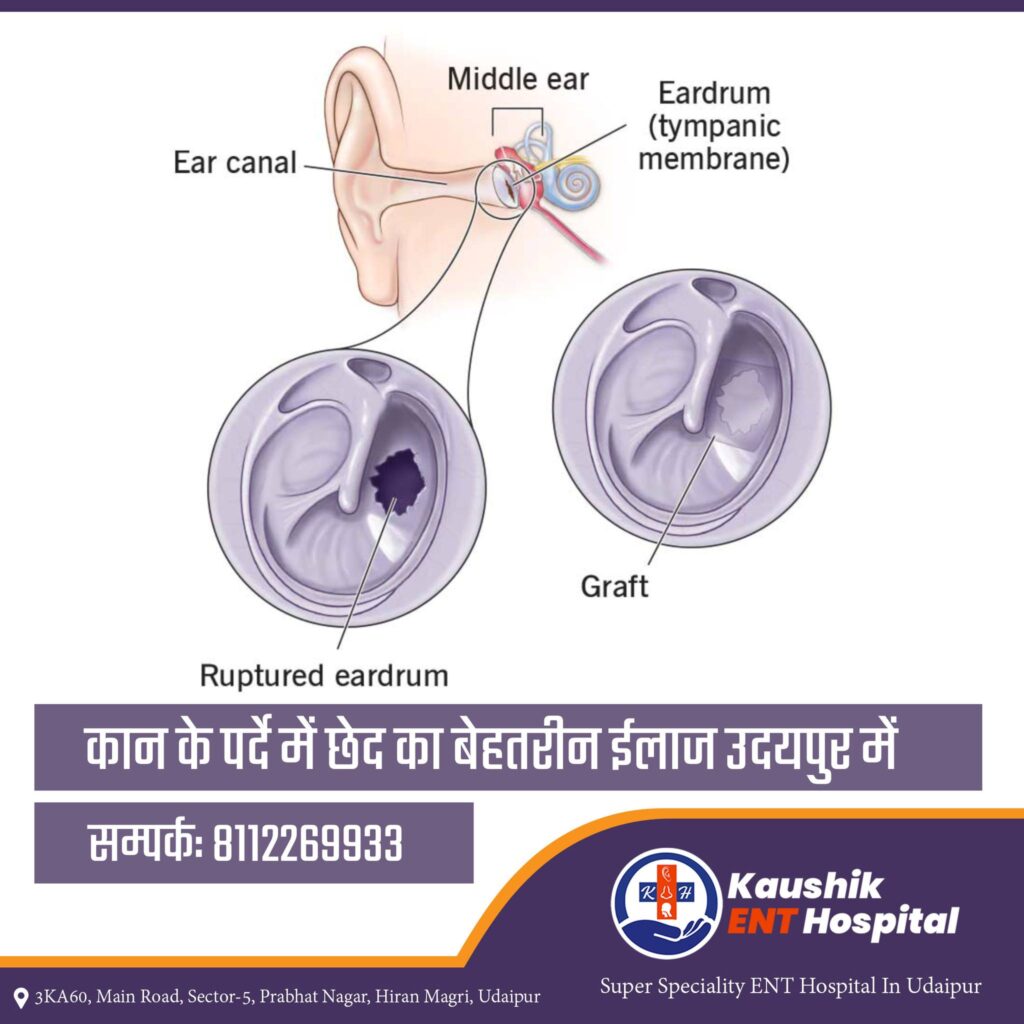What is a Tympanoplasty
Tympanoplasty is a surgical procedure to repair the eardrum (tympanic membrane) and/or the middle ear bones. The goal of the surgery is to improve hearing, relieve symptoms, and prevent complications associated with a perforated eardrum or middle ear damage.
There are several reasons why a tympanoplasty might be necessary, including:
- A hole or tear in the eardrum can cause hearing loss, ear pain, and discharge.
- Recurring ear infections can damage the eardrum and middle ear bones.
- The Eustachian tube connects the middle ear to the back of the throat and helps to regulate air pressure. Dysfunction can lead to eardrum perforation or middle ear damage.
- A head injury or sudden loud noise can cause a perforated eardrum or middle ear damage.
- A cyst-like structure that can develop in the middle ear and cause damage to the eardrum and middle ear bones.
Severe Head Injury: If a person requires tympanoplasty, general anesthesia is first administered so that you remain unconscious during the procedure. Initially, the surgeon will use a laser to carefully remove any excess or scar tissue present in the middle ear. Then, a small piece of your own tissue, taken from the vein or muscle sheath, will be grafted onto your eardrum to close the perforation. Additionally, the surgeon might access the eardrum through the ear canal to repair it, or alternatively, make a small incision behind the ear to reach the eardrum.
This gives a clear overview of the tympanoplasty procedure and how it is performed.
The purpose of tympanoplasty is primarily to address issues related to a perforated or damaged eardrum. Here are the key objectives of the procedure:
- Repair the Eardrum: Tympanoplasty aims to close the perforation in the eardrum (tympanic membrane) to restore its integrity. This repair helps in protecting the middle ear from infections and external contaminants.
- Improve Hearing: By repairing the eardrum, the surgery can enhance hearing ability. A perforated eardrum can disrupt the normal conduction of sound, leading to hearing loss. Tympanoplasty helps in restoring better hearing function.
- Prevent Recurrent Ear Infections: A perforated eardrum can lead to frequent ear infections. Repairing the eardrum reduces the risk of these infections and helps maintain ear health.
- Repair Middle Ear Structures: In some cases, tympanoplasty also involves repairing or reconstructing damaged structures in the middle ear, such as the ossicles (tiny bones that aid in sound transmission).
- Relieve Symptoms: The surgery can alleviate symptoms associated with eardrum perforation, such as ear pain, discharge, and a sensation of fullness or pressure in the ear.
- Improve Quality of Life: By addressing hearing loss and reducing the risk of infections, tympanoplasty can enhance the overall quality of life for individuals affected by eardrum damage.

What are the Purpose of Tympanoplasty
- Pain in the Ear: Experiencing discomfort or pain in the ear.
- Bleeding from the Ear: Presence of blood coming from the ear.
- Fluid Leakage and Discharge: Leakage of fluid or discharge from the ear.
- Ringing in the Ear: Hearing a ringing or buzzing sound in the ear, often referred to as tinnitus.
- Dizziness: Feeling lightheaded or experiencing vertigo.
- Nausea and Vomiting: Feeling sick to the stomach or vomiting.

Kaushik-ENT-Hospital-Udaipur-1024×1024-1.jpg
What are the Procedure of Tympanoplasty
Diagnosis of Ear Infection:
- Microscopic Examination: To diagnose an ear infection, the doctor may examine ear discharge under a microscope to detect bacteria or other microorganisms.
- Rinne and Weber Tests: Tuning fork tests help determine which part of the ear is damaged – the inner ear or the middle ear.
- Tympanometry: This test measures the eardrum’s response to changes in pressure. It can also detect abnormalities in the functioning of the middle ear.
- Audiology Examination: Conducted to assess hearing loss and evaluate the extent of hearing impairment.
Treatment:
- Removal of Tissue: Using lasers or micro-hooks, the surgeon removes additional folds and damaged tissue around the eardrum to ensure complete access to the tear.
- Closure: The incision made in the ear is closed with stitches.
- Grafting: A graft is taken from the skin behind the ear or from a lobe of the ear and placed underneath the remaining eardrum. The graft is then stitched to close the perforation and ensure proper function.
- Ossiculoplasty: This procedure can be performed alongside tympanoplasty to repair the eardrum and reconstruct the ossicles (tiny bones in the middle ear) to bridge any gaps and restore proper hearing function.

How to Care After Tympanoplasty
- After ear surgery, the patient may need at least one week of rest. Additionally, the doctor may provide the patient with ear packs. To maintain hygienic conditions, it is important to regularly change the cotton in the ear packs.
- After ear surgery, you should avoid swimming and getting water into the ears, as it’s important to prevent water from entering the ear canal. The doctor may recommend wearing a shower cap during bathing.
- After ear repair surgery, it’s advised to avoid high altitudes, air travel, and scuba diving to prevent any pressure changes in the ears.








Leave A Comment